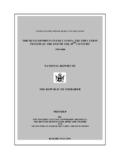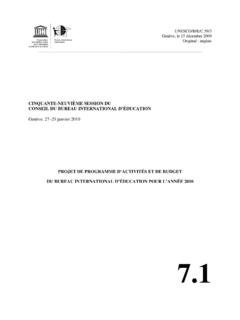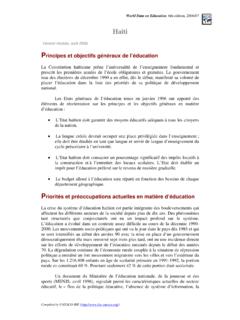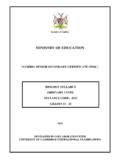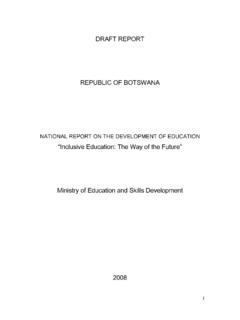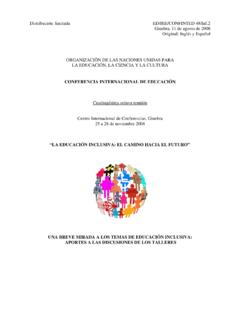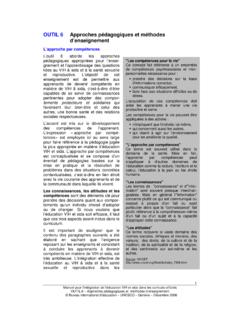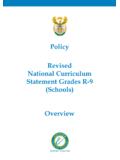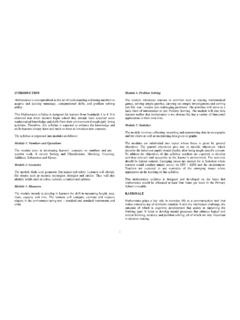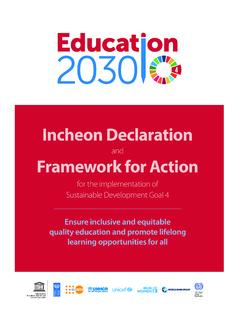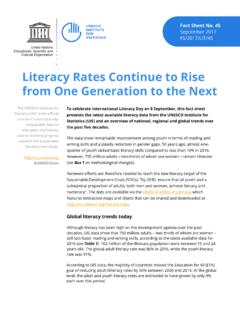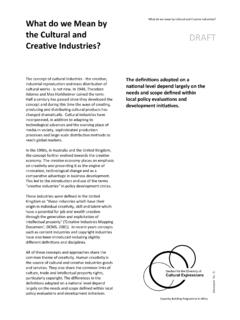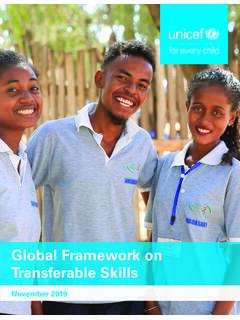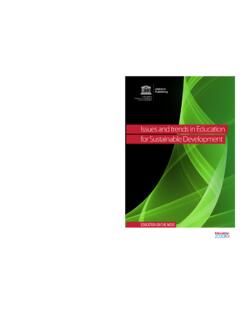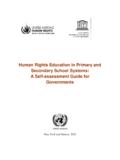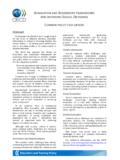Transcription of Guidelines for inclusion: ensuring access to education for ...
1 Guidelinesfor inclusion : ensuring Accessto education for AllAcknowledgments In unesco s efforts to assist countries in making National Plans for education more inclusive, we recognised the lack of Guidelines to assist in this important process. As such, the Inclusive education Team, began an exercise to develop these much needed tools. The elaboration of this manual has been a learning experience in itself. A dialogue with stakeholders was initiated in the early stages of elaboration of this document. Guidelines for inclusion : ensuring access to education for All , therefore, is the result of constructive and valuable feedback as well as critical insight from the following individuals.
2 Anupam Ahuja, Mel Ainscow, Alphonsine Bouya-Aka Blet, Marlene Cruz, Kenneth Eklindh, Windyz Ferreira, Richard Halperin, Henricus Heijnen, Ngo Thu Huong, Hassan Keynan, Sohae Lee, Chu Shiu-Kee, Ragnhild Meisfjord, Darlene Perner, Abby Riddell, Sheldon Shaeffer, Noala Skinner, Sandy Taut, Jill Van den Brule-Balescut, Roselyn Wabuge Mwangi, Jamie Williams, Siri Wormn s and Penelope in 2005by the United Nations Educational,Scientifi c and Cultural Organization7, place de Fontenoy, 75352 PARIS 07 SPComposed and printed in the workshops of unesco unesco 2005 Printed in France(ED-2004/WS/39 cld 17402)ForewardThis report has gone through an external and internal peer review process, which targeted a broad range of stakeholders including within the education Sector at unesco headquarters and in the fi eld, Internal Oversight Service (IOS) and Bu-reau of Strategic Planning (BSP).
3 These Guidelines were also piloted at a Regional Work-shop on Inclusive education in Bangkok. A wide range of experts from the Asia Pacifi c region provided feedback for further development. Finally, this document was circulated to Steering Committee of the Flagship The Right to education for Persons with Disabilities: Towards inclusion . This document is a response to the need for a systematic approach for identifying excluded groups. It is intended to be a living document which serves as a dynamic tool of analysis which will be revised in the coming years to refl ect the reality of marginalized and excluded children. AbstractOver half a billion persons are disabled as a result of mental, physical or sensory im-pairment.
4 These individuals are often limited by both physical and social barriers which exclude them from society and prevent them from actively participating in the development of their nations. Approximately 80 per cent of the world s disabled population lives in developing countries. The key to unlocking this potential rests in the minds of men; it is through education and the respect for the rights of all individuals that change can effectively take place. Today there are an estimated 140 million children who are out of school, a majority being girls and children with disabilities. Among them, 90% live in lower middle-income countries and over 80% of these children are in Africa.
5 There are countless others within the school system not receiving quality education . How many of these children who are not attending school live in your country? How can we take steps towards ensuring that these children, who have a right to education , are not left behind? This document provides Guidelines and concepts for rendering National education Plans / education for All (EFA) more inclusive, with the objective of ensuring access and quality education for ALL learn-ers. This paper is intended to systematize how excluded children are planned for in edu-cation. It begins with a brief introduction, which provides a historical perspective on the origins of inclusion and describes the shift from integration towards inclusion .
6 It is then divided into three main parts. The fi rst provides a theoretical framework . It defi nes inclu-sion, explains how it is founded in a human rights approach and how is relates to factors such as quality and cost-effectiveness. The second part looks at more practical changes at the school level. It outlines the key elements in the shift towards inclusion with a particu-lar focus on the key players including teachers, parents and educational policymakers as well as curricula. The third part brings together the fi rst two sections by providing tools for policymakers and educational planners for hands-on analysis of education plans. These Guidelines are intended to provide information and awareness, to be a policy tool for revising and formulating EFA plans, and to serve as a basis for discussion among policymakers, educators, NGOs and international organizations impacting policy in both private and public education and concerned with promoting access for ALL Guidelines attempt to demystify the notions surrounding inclusion and dem-onstrate that challenges can be overcome through a willingness to change attitudes regard-ing inclusion .
7 By following these Guidelines , those working with and analyzing National Plans for education can identify gaps and strategies in order to take steps to ensure that inclusion is achieved within their educational systems and that every child has access to a quality 1 inclusion s Origins in Special education : The Shift from Integration to inclusion 2 How inclusion Relates to education for All 1 Why inclusion Rationale & Rights 1 inclusion in education a human right Figure : The Rights framework for inclusion 2 How is inclusion defi ned? 3 inclusion how does it relate to quality?
8 4 inclusion and cost effectiveness 2 Key Elements in the Shift towards inclusion Resource & Recourse 1 Key players in support of inclusion who are they? 2 Attitudes and values how can they affect inclusion ? Figure : Understanding the process of inclusion 3 Accessible and fl exible curricula how can they serve as keys to schools for all? Figure : education through the inclusion Lens 4 inclusion empowering for All? 3 Inclusive education and education for All Reflection & Reform 1 Tools for Educational Planners and Policymakers 2 Steps Towards inclusion Checklist 3 Strategic Planning for inclusion - inclusion Matrix Worksheet Annex 1 EFA & Millennium Developement Goals References and further reading 9 Introduction1 inclusion s Origins in Special education : The Shift from Integration to InclusionInclusion as we know it today has its origins in Special education .
9 The development of the fi eld of special education has involved a series of stages during which education systems have explored different ways of responding to children with disabilities, and to students who experience diffi culties in learning. In some cases, Special education has been pro-vided as a supplement to general education provision, in other cases it has been entirely separate. In recent years, the appropriateness of separate systems of education has been challenged, both from a human rights perspective and from the point of view of effective-ness. Special education practices were moved into the mainstream through an approach known as integration . The main challenge with integration is that mainstreaming had not been accompanied by changes in the organisation of the ordinary school, its curriculum and teaching and learning strategies.
10 This lack of organisational change has proved to be one of the major barriers to the implementation of inclusive education policies. Revised thinking has thus led to a re-conceptualisation of special needs . This view implies that progress is more likely if we recognize that diffi culties experienced by pupils result from the ways in which schools are currently organized and from rigid teaching methods. It has been argued that schools need to be reformed and pedagogy needs to be improved in ways that will lead them to respond positively to pupil diversity seeing individual differences not as problems to be fi xed, but as opportunities for enriching learning. 2 How inclusion relates to education for All?
